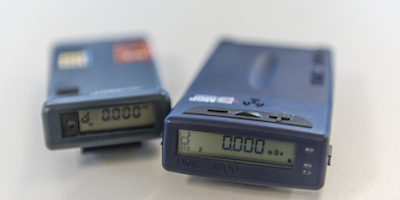Dosimeters are devices used to measure the amount of energy deposited by ionising radiation. This measurement is used to estimate the effective dose received by the human body through exposure to external ionising radiation. Doses received following internal exposure from incorporation of radioactivity are not assessed by these dosimeters but if necessary determined through other methods.
The different types of dosimeter and systems used at CERN are:
- Personal dosimeter (DIS-1 + CR39)
- Operational dosimeter (DMC2000 or DMC3000)
- Extremities dosimeter, usually for hands, feet or eyes
The personal dosimeter is mandatory for all workers occupationally exposed to ionising radiation, whilst the operational dosimeter is complementary and required only for certain areas or activities. Extremity dosimeters are worn if required by the Radiation Protection Group, usually when high local doses to the extremities or eyes can be expected.
Personal dosimeter

You will require a personal dosimeter (DIS) as soon as you need to work in a Radiation Area. This dosimeter is personal and not transferable.
The personal dosimeter is sometimes referred to as: legal dosimeter, passive dosimeter, individual or DIS dosimeter. In the past, when a different technology was used, this dosimeter was called a 'film badge'.
The personal dosimeter actually includes two dosimeters: one to measure gamma and beta radiation (DIS-1) and a second one to measure neutron radiation (CR39).
When you read your dosimeter at one of the dosimeter reader stations, only the gamma/beta dosimeter readout value will be shown. The neutron dosimeter is evaluated on the annual exchange of the dosimeter. The complete result of gamma/beta and neutron dose will be displayed on your official records after evaluation and validation by the Dosimetry Service.
Operational dosimeter

The operational dosimeter is required, in addition to your personal dosimeter, for working in Limited Stay and High Radiation Controlled Radiation Areas. For specific activities or for optimisation purposes, the Radiation Protection Group can also recommend using these dosimeters outside these areas.
The operational dosimeter is sometimes referred to as: active dosimeter, electronic dosimeter or DMC.
The operational dosimeter features a direct dose display, audible indication of the radiation level and alarm functions when thresholds for dose or dose rates are exceeded.
It can either be assigned permanently to a person or can be used in 'pool' mode. For the latter, the dosimeter is not assigned to a specific person and can be shared amongst colleagues. It will be attributed to the user by the reader station when switching it to ON.
Extremity dosimeters

The Dosimetry Service provides extremity dosimeters for interventions where higher doses to the extremities (hands, feet) and/or eyes are likely to occur. The Radiation Protection Group assesses whether it is necessary to wear an extremity dosimeter within the work and dose planning process. A typical extremity dosimeter would be a finger ring integrating a thermoluminescence-based detector. The finger ring dosimeter has a detection limit of about 0.2-0.3 mSv. Doses are reported for doses equal or higher than 0.5 mSv.
